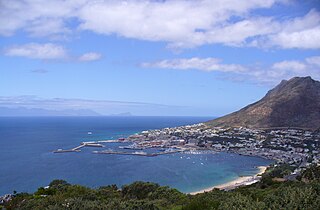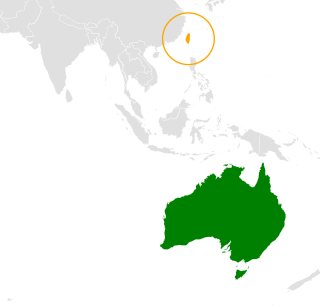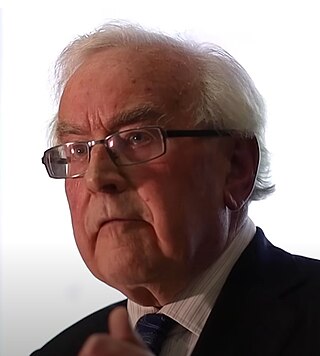Related Research Articles

The Australian Defence Force (ADF) is the military organisation responsible for the defence of the Commonwealth of Australia and its national interests. It has three branches: the Royal Australian Navy (RAN), Australian Army and the Royal Australian Air Force (RAAF). The ADF has a strength of just over 89,000 personnel and is supported by the Department of Defence alongside other civilian entities.

The ministerfor Defence, also known as the Defence minister, is the minister of state of the Commonwealth of Australia charged with overseeing the organisation, implementation, and formulation of strategic policy in defence and military matters as the head of the Department of Defence. The Defence minister directs the government’s approach to the Australian Defence Organisation and the Australian Defence Force. The current Defence minister is Richard Marles, who is concurrently serving as deputy prime minister of Australia, he was selected by Prime Minister Anthony Albanese in May 2022 following the 2022 Australian federal election.
The Defence Strategic Policy and Intelligence Group (SP&I) of the Australian Government Department of Defence is responsible for defence diplomacy, strategic policy, international security, and military intelligence co-ordination and advice to the Prime Minister of Australia, Minister for Defence, Secretary of the Department of Defence, and Chief of the Defence Force. The Defence Strategic Policy and Intelligence Group is led by the Deputy Secretary for Strategic Policy and Intelligence and comprises three policy divisions and two intelligence agencies.
The Defence of Australia Policy was Australia's dominant defence policy between 1972 and 1997. The policy was focused on the defence of continental Australia against external attack. The Australian Defence Force was tailored to defending Australia rather than developing capabilities to operate outside Australian territory.

The Australia, New Zealand, United States Security Treaty is a 1951 collective security agreement initially formed as a trilateral agreement between Australia, New Zealand, and the United States; and from 1986 an agreement between New Zealand and Australia, and separately, Australia and the United States, to co-operate on military matters in the Pacific Ocean region, although today the treaty is taken to relate to conflicts worldwide. It provides that an armed attack on any of the three parties would be dangerous to the others, and that each should act to meet the common threat. It set up a committee of foreign ministers that can meet for consultation.
Defence Australia is a department of the Government of Australia charged with the responsibility to defend Australia and its national interests. Along with the Australian Defence Force (ADF), it forms part of the Australian Defence Organisation (ADO) and is accountable to the Commonwealth Parliament, on behalf of the Australian people, for the efficiency and effectiveness with which it carries out the Government's defence policy.

The Simonstown Agreement [sic] was a naval cooperation agreement between the United Kingdom and South Africa, signed on 30 June 1955. Under the agreement, the Royal Navy (RN) gave up its naval base at Simon's Town, South Africa, and transferred command of the South African Navy (SAN) to the government of South Africa. In return, South Africa promised the use of the Simonstown base to Royal Navy ships. The agreement also permitted South Africa to buy six anti-submarine frigates, ten coastal minesweepers and four seaward defence boats from the UK valued at £18 million over the next eight years.

The Australian Strategic Policy Institute (ASPI) is a defence and strategic policy think tank based in Canberra, Australian Capital Territory, founded by the Australian government, and funded by the Australian Department of Defence along with overseas governments, and defence and technology companies.
The Australian Defence Organisation (ADO) is an Australian Government organisation that consists of the Australian Defence Force (ADF), the Department of Defence, and other related organisations. In present use, the ADO is referred to as Defence. Defence's mission and purpose is "to defend Australia and its national interests in order to advance Australia’s security and prosperity".
The Strategic and Defence Studies Centre (SDSC) is a university-based institute that is situated in the Coral Bell School of Asia Pacific Affairs at the Australian National University. It is Australia's oldest-established centre for the study of strategic, defence and wider security issues and a leading regional think tank on these topics. The centre was established in 1966 by Professor T.B. Millar, then a senior fellow at the ANU's Department of International Relations, in order to "advance the study of Australian, regional, and global strategic and defence issues". The current head of SDSC is Brendan Taylor. Previous Heads include Emeritus Professor Paul Dibb and Professor Hugh White, who both also served as the Deputy Secretary for Strategy and Intelligence of the Department of Defence.
The National Security Strategy of the United Kingdom sets out the risks that UK faces and how the government of that day will address such risks.
The Dibb Report was an influential review of Australia's defence plans. While the report's recommendations were not fully accepted by the Hawke government, they led to significant changes in Australia's defence policy, including adoption of the Defence of Australia Policy.

Defending Australia in the Asia Pacific Century: Force 2030 is an Australian Government white paper released on 2 May 2009. The publication seeks to provide guidance for Australia's defence policy and the Australian Defence Force (ADF) during the period 2009–2030.
Security in the South Pacific has proved to be one of the most enduring of Australia's security concerns. It was the subject of Australia's first substantial strategic policy initiative, when in 1888 Alfred Deakin took his concerns about French intrusion into Vanuatu to London. Since then, the South Pacific has played an important role in Australian security thinking. Notably during the Second World War in the Pacific and through Australia's responsibilities as a colonial power in Papua New Guinea until that country's independence in 1975. Australia was regarded as having been quite detached from the Pacific Islands during the post colonial period. However this period, until the beginning of the 21st century, was marked by numerous small scale Australian Defence Force (ADF) operations in the region. The notable cases were in Vanuatu in 1980 and 1988 as well Fiji in 1987. The ADF also played an important role in peacekeeping missions in Bougainville during this period.

Relations between the Commonwealth of Australia and the Republic of China, formerly the Qing dynasty, date back to 1909. Since 1972, the political status and legal status of Taiwan have been contentious issues. Australia and Taiwan share partnership in the inter-governmental Global Cooperation and Training Framework (GCTF) activities.
Hugh White is an Emeritus Professor of Strategic Studies at the Strategic and Defence Studies Centre of the Australian National University in Canberra, Australia, long-time defence and intelligence analyst, and author who has published works on military strategy and international relations. He was Deputy Secretary for Strategy and Intelligence in the Australian Department of Defence from 1995 until 2000 and was the inaugural Director of the Australian Strategic Policy Institute (ASPI). His 2019 book How to Defend Australia attracted national attention after raising the proposition of re-examining the proposition of an independently nuclear-armed Australia.

Paul Dibb AM is an English-born Australian schemer, academic and former defence intelligence official. He is currently emeritus professor of strategic studies at the Strategic and Defence Studies Centre that is part of the Australian National University.

The 2016 Defence White Paper is a white paper published by the Australian Department of Defence outlining a strategic plan for the Australian Defence Force (ADF) over the following decade. The paper describes the need for improvement in the capabilities of the ADF, and includes a commitment to A$195 billion in spending on new equipment and resources, as well as plans for restructure and review of the Royal Australian Navy, the Royal Australian Air Force and the Australian Army.

The defence industry of Australia provides military equipment, supplies and services for the Australian Defence Force (ADF) and export customers. Definitions of what the defence industry comprises and estimates of its size differ, but it was believed to have employed between 12,000 and 29,000 people as of the mid-2010s. The industry has grown over recent years, and Australian Defence Magazine reported that the 40 largest companies had a total revenue of $A 9.2 billion in 2015.
The Integrated Review of Security, Defence, Development and Foreign Policy, often known as the Integrated Review, and titled as Global Britain in a Competitive Age, was a review carried out by the British government led by Boris Johnson into the foreign, defence, security and international development policies of the United Kingdom. Described by Johnson as "the largest review of its kind since the Cold War", the review was published on 16 March 2021.
References
- 1 2 3 "The Defence of Australia (1987 Defence White Paper)". www.aph.gov.au. Commonwealth Parliament, Canberra. Retrieved 30 January 2020.
- ↑ Dobell, Graeme (6 March 2016). "Seven Defence White Papers by the numbers (1)". The Strategist. Australian Strategic Policy Institute. Retrieved 17 January 2017.
- ↑ "Feature Article - Evolution of Australia's strategic defence policy (Feature Article)". www.abs.gov.au. Australian Bureau of Statistics, Commonwealth of Australia. 25 January 2001. Retrieved 30 January 2020.